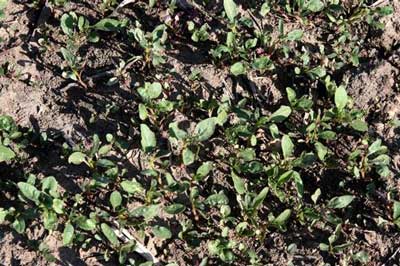
In numerous fields, uncontrolled waterhemp is being found. What is the advisability of making a second post-emergence herbicide application to control these late waterhemp plants?
Waterhemp is capable of germinating through most of the growing season. In the past, many individuals have noted late-emerging, tiny waterhemp plants that successfully flower and produce seed. For these late-emerging populations, a timely herbicide application should provide some level of control as long as the waterhemp plants are within labeled size restrictions and as long as other conditions are favorable. In many fields, the soybean canopy should now be regarded as an impediment to effective spray coverage of weeds.
Unfortunately, many of the current, late waterhemp observations have actually been of plants that we were unsuccessful in controlling with the first herbicide pass. Some of these survivor waterhemp plants could now be very tough, and/or larger than the recommended label height restrictions. Or, even worse, some of these survivors may be resistant to the particular herbicide or herbicides that are being applied. Illinois, in particular, has been cited as a state in which certain waterhemp populations are resistant to five herbicide groups at once. Reports of PPO resistant waterhemp are increasing in Illinois. Since waterhemp is a dioecious species (having male and female flowers on different plants), pollen may easily move from field to field and transfer herbicide resistance.
If the decision is made to treat the late waterhemp problem, consider that most work with PPO herbicides indicates that warmer temperatures with high relative humidity helps increase control. A graduate research project, conducted by Dr. David Powell, showed up to a 30% increase in waterhemp control with certain PPO herbicides in those environments. Given a range of climate conditions, if it is hot with low humidity, it would be preferable to wait and spray when conditions are milder with a higher relative humidity. This may be as simple as choosing to wait and spray at mid-morning, instead of in the afternoon. Dr. Powell’s research showed little risk for negative soybean yield response from these herbicide applications until the R3 soybean growth stage.
Many experts also recommend higher water volumes (20-40 gallons per acre) and coarse spray droplets for application of PPO herbicides. Time of day for the spray application can be important, with 10 a.m. to 4 p.m. being the preferred spray timing window. This timing permits sunlight to assist with the contact activity of the herbicide.
Where a second herbicide application for this season is judged to be too risky, or weeds are already outside of labeled size restrictions, consider working with the grower now to develop the waterhemp management plan for next year. This plan should include robust use of pre-emergence residual herbicides.